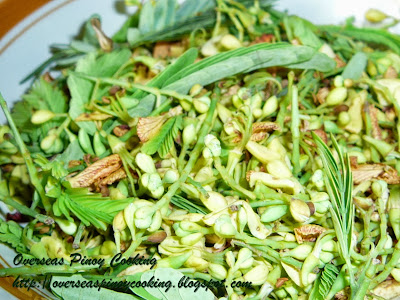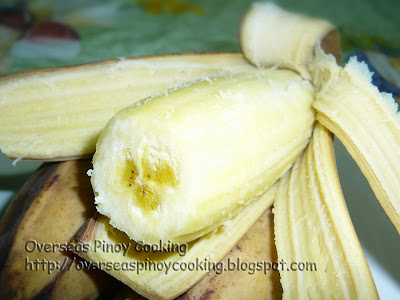Sinampalukang Manok
Sinampalukang Manok, Chicken in Tamarind Flowers and Young Leaves. Compared to chicken sinigang that is soured with tamarind fruit, this dish has a milder sourness which is just perfect with the chicken. It gives also a distinct milky broth that is so comporting to sip or it's so perfect to place in your hot rice. This dish is most likely that you have just heard off or seldom have it unless you are from the province or countryside when the tamarind trees are in bloom. Occasionally tamarind flowers and young leaves can be found in Metro Manila vegetable markets when they are in season. Now if you happen to chance upon it at your vegetable market and craving for sinampalukang manok here is a very simple way to cook it.
Ingredients:
1 kilo chicken, chopped to serving pieces
2 to 3 cups, tamarind flowers and young buds
2 medium size onion, quartered
1 bundle sitaw, cut into 2” length
3 pieces eggplant, cut into wedges
1 bundle okra, cut into halves crosswise
salt
Cooking procedure:
Wash chicken thoroughly. In a large pot, boil 6-8 cups of water, Add onion, tamarind flowers and young buds then simmer for 2 to 3 minutes. Add in chicken and continue simmering for 15 to 20 minutes or until chicken is tender. Remove scum that rises. Season with salt to taste. Add in vegetables and, cook for another 2 to 3 minutes or until vegetables are just cooked but firm. Serve hot.
Ingredients:
1 kilo chicken, chopped to serving pieces
2 to 3 cups, tamarind flowers and young buds
2 medium size onion, quartered
1 bundle sitaw, cut into 2” length
3 pieces eggplant, cut into wedges
1 bundle okra, cut into halves crosswise
salt
Cooking procedure:
Wash chicken thoroughly. In a large pot, boil 6-8 cups of water, Add onion, tamarind flowers and young buds then simmer for 2 to 3 minutes. Add in chicken and continue simmering for 15 to 20 minutes or until chicken is tender. Remove scum that rises. Season with salt to taste. Add in vegetables and, cook for another 2 to 3 minutes or until vegetables are just cooked but firm. Serve hot.






We have a tamarind tree where I live, but I also see young leaves in the market these days. I once cooked sinampalukang manok with the leaves, but also with the fruit. I didn't know that the leaves can be enough on their own. I'll try this recipe. I also had an excellent beef stew with tamarind leaves in Cabanatuan before.
ReplyDeletekai, Using the young leaves and flowers alone will give your broth a slight sourness only compared to the regular sinigang, but if you prefer a really sour broth you could use more quantity or in addition the fruits as you mentioned. If your don’t want all those leaves floating in the broth, boil them separately and filter them out using a sieve or cheese cloth
ReplyDeleteHello, po! Ano pong ulam ngayon? he he he!
ReplyDeletethis dish is surely a winner among Pinoys.
anyway po, please do check out my blog as I tagged you there. thanks po!
hello hot momma,
ReplyDeleteLOL...
thanks for the tag...
we recently vacationed in Alaska and brought in Red Salmon and I'm going to try it with sampaloc leaves. My mouth is already watering just thinking about it. I will let you know the outcome later!
ReplyDeletealternatives for tamarind leaves
ReplyDeleteTo Anonymous, Just use the sampalok (tamarind)sinigang mix if its not available in your location.
ReplyDeletehi,
ReplyDeleteif il put sinigang mix instead of tamarind flowers,is it means ill pour on the sinigang along the onion or il do it after..
tenx..
Add the mix towards the end of cooking.
ReplyDeleteYummy! one of my favorite dish.
ReplyDeleteok tong site na to kaso sana magtagalog ka na lang, sablay ang english mo e - mang mags
ReplyDeleteSalamat po mang Mags,
ReplyDeletePasensya ka na sa English ko, sinabi ko na rin sa maraming pagkakataon na talagang mahina ako sa grammar. English kasi ang gamit ko para mas marami tayong maabot at matulongan magluto. Mas importante po sa aking ang maishare ang kunting kaalaman natin sa pagluluto...